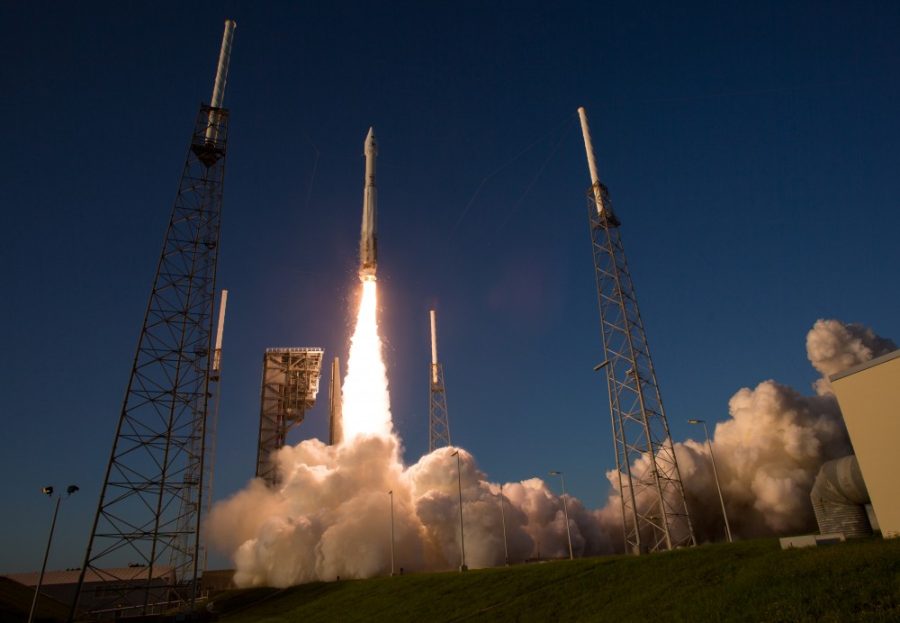NASA’s OSIRIS-REx spacecraft will make its first attempt to collect a sample from asteroid Bennu on Oct. 20.
Dante Lauretta, OSIRIS-REx principal investigator and a professor of planetary science and cosmochemistry at the University of Arizona, got started on this project in 2004. For seven years, he had worked on writing and developing proposals to send to NASA. He finally won in 2011, and he became the leader of the program.
Lauretta explained that they got to the asteroid in 2018 and spent all of 2019 mapping it in extreme detail. The reason for this was to be able to select a sampling site.
This past week the team has been doing the final checking on all of the commands for the spacecraft and getting those setup. They are mainly focusing on getting the spacecraft in the correct position for the sampling site.
This will not be an easy task, especially with the building-sized boulder situated on Nightingale crater’s eastern rim. This boulder could pose a hazard to the spacecraft as it backs away from the asteroid after collecting the sample.
Lauretta explained that they have made the spacecraft very smart, so it knows which areas of the asteroid’s surface are hazardous and which areas are safe.
“The spacecraft is taking pictures as it descends down to the asteroid’s surface and calculating onboard where it is going to make contact and it calculates if it is going to get too close to what I call Mount Doom,” said Lauretta.
If it does calculate it is getting too close to the boulder, it will fire its engines and move away from the asteroid, letting Lauretta and the team know that it calculated the point of contact as hazardous. In this case, the team will then have to try again.
The most challenging part for Lauretta and the team has been the rough and rugged surface of the asteroid. They had expected it to be a much smoother surface which led to them having to adapt the spacecraft software system to do the hazard checking. The system also had to adapt so that when the spacecraft leaves orbit, and it is on its way down to the Nightingale crater, it’s calculating its position and its velocity the entire time.
After they make contact on Tuesday, they will go through a week of assessments to see how successful they were. This includes estimating the mass of the sample that is in the sampling filter mechanism.
They need at least 60 grams of material in order to stow the sample into a return capsule and to begin planning the journey back to Earth. If they do not collect enough of a sample, they will then plan for a second sampling attempt next year.
The sampling mechanism of the spacecraft will touch Bennu’s surface for several seconds and fire a charge of pressurized nitrogen to disturb the surface in order to collect the sample.
This sampling mechanism was chosen because, when they were deciding the strategy, Lauretta and the team had a list of certain criteria. They knew that they would only be in contact with the asteroid for a short period of time so they needed a mechanism that could collect 60 grams in five seconds. They also wanted a system that would keep the sample pristine and clean, which means they don’t want a lot of mechanical motions like a drill.
“We thought about claws or scoops where we could grab material off the surface, but it has to work in the microgravity environment on the asteroid, so we settled on this idea of something like a vacuum cleaner,” Lauretta explained.
The sampling mechanism acts like a vacuum cleaner in the sense that it uses air pressure to push the dirt and the rocks through a filter.
“There is no air on the asteroid, so we brought our own air and it is kind of more like a leaf blower, where you blow the air down and it pushes all the gravel up into the filter,” Lauretta said.
Lauretta’s objective with this mission is to learn about origins.
“We are really interested in Bennu because it is an ancient asteroid that dates back to before the Earth existed,” Lauretta added.
They think that objects like this asteroid may have been responsible for making Earth a habitable planet. Specifically, they think it may have brought the water that created Earth’s oceans and also the organic matter that ultimately led to the origin of life on Earth.
“We are really interested in the organic chemistry and the amount of water that is in the sample and trying to understand how Earth became habitable and how the origin of life occurred,” Lauretta said.
Follow Jillian Bartsch on Twitter









